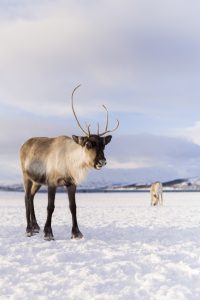Reindeer – December Blog
The Scottish Highlands were once home to herds of Rangifer tarandus, better known as Reindeer roaming free across the landscape. Over 1,000 pieces of reindeer antler have been found in the Bone Caves in Sutherland, with dates ranging from as far back as 47,000BC. The large number of reindeer bone found in these caves has given rise to the theory that this part of Assynt was used as a calving ground. It’s thought the Reindeer went extinct in Scotland around 7,000 years ago from a mixture of over hunting and natural climate change. To discover more about the bone caves watch our video:Bone Caves of Assynt

In 1952, Reindeer were re-introduced to Scotland by Mikel Utsi, a Swedish Sami. Whilst Honeymooning in the highlands, he saw many similarities between his home in Sweden and the Cairngorm Mountains and returned to experimentally introduce a small herd of reindeer. In the intervening 60 years this herd has grown to around 150 animals, who are known to be friendly and curious with visitors.
Reindeer are ruminants – just like cows and sheep. They are members of the Cervidae family and are genetically close to Red Deer.
Reindeer are the only cervid species that live in arctic and subarctic regions. Their range is vast spanning from North America, through Russia and into Asia, where they live wild. Reindeer are able to feed on lichens and fungi extensively, which is why they are particularly suited to the high plateau of the Cairngorm National park. Their ability to digest lichen is due to a gene for an enzyme called lichenase, this enables their gut to break down lichen and extract glucose from it. Lichens will form around 90% of their winter diet, when other food is scarce or unavailable, and they will often need to dig through snowpacks to find it.
Reindeer have been the ones most inclined to domestication. Archaeological evidence points to domestication taking place around 3000BC, which is just as well for Santa, as he needs them to pull his sleigh. Archaeological evidence, including cave paintings shows reindeer development and the first uses of saddles and sleds with these animals. Humans have relied on reindeer for their fur, milk and meat as well as transportation, in theses northerly and inhospitable habitats reindeer have enabled humans to survive.
All male reindeer (bulls) will grow antlers, which they shed and regrow every year, shedding them after the mating season in early December. Reindeer are the only cervids in which females (cows) grow antlers and unlike the males – they keep theirs through the winter months – so those reindeer pulling Santa’s sleigh are highly likely to be cows.
Finally, we all know that Rudolph had a bright red nose to help Santa see his way through the long night of delivering gifts and actually Reindeer really do have brilliant red hot noses. This phenomenal nasal structure is able to warm the freezing air by up to 80 degrees Celsius by the time it reaches their lungs. The nose then retains the heat of the breath as it exhales much cooler air. This incredible mechanism means reindeer can conserve warmth in arctic conditions of -40C.
